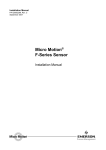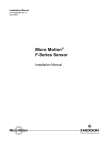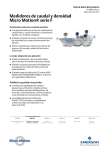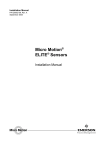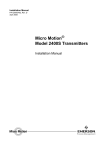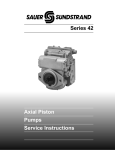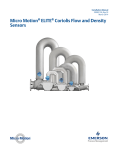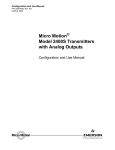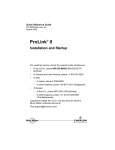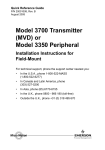Download Emerson Micro Motion F-Series Sensor Installation manual
Transcript
Installation Manual 20002298, Rev CC December 2010 Micro Motion® F-Series Coriolis Flow and Density Sensors Safety and approval information This Micro Motion product complies with all applicable European directives when properly installed in accordance with the instructions in this manual. Refer to the EC declaration of conformity for directives that apply to this product. The EC declaration of conformity, with all applicable European directives, and the complete ATEX Installation Drawings and Instructions are available on the internet at www.micromotion.com/atex or through your local Micro Motion support center. Information affixed to equipment that complies with the Pressure Equipment Directive can be found on the internet at www.micromotion.com/documentation. For hazardous installations in Europe, refer to standard EN 60079-14 if national standards do not apply. Other information Full product specifications can be found in the product data sheet. Troubleshooting information can be found in the transmitter configuration manual. Product data sheets and manuals are available from the Micro Motion web site at www.micromotion.com/ documentation. Return policy Micro Motion procedures must be followed when returning equipment. These procedures ensure legal compliance with government transportation agencies and help provide a safe working environment for Micro Motion employees. Failure to follow Micro Motion procedures will result in your equipment being refused delivery. Information on return procedures and forms is available on our web support system at www.micromotion.com, or by phoning the Micro Motion Customer Service department. Micro Motion customer service Location Telephone number U.S.A. 800-522-MASS (800-522-6277) (toll free) Canada and Latin America +1 303-527-5200 (U.S.A.) Asia Europe Japan 3 5769-6803 All other locations +65 6777-8211 (Singapore) U.K. 0870 240 1978 (toll-free) All other locations +31 (0) 318 495 555 (The Netherlands) Customers outside the U.S.A. can also send an email to [email protected]. Contents Contents Chapter 1 Planning ...........................................................................................................................1 1.1 1.2 1.3 Chapter 2 Mounting .........................................................................................................................4 2.1 2.2 Chapter 3 Installation checklist ........................................................................................................................1 Best practices ..................................................................................................................................2 Environmental limits .......................................................................................................................2 Mount the sensor ............................................................................................................................4 Attach extended electronics ............................................................................................................5 Wiring ..............................................................................................................................7 3.1 3.2 3.3 Options for wiring ...........................................................................................................................7 Connect 4-wire cable ......................................................................................................................7 Connect 9-wire cable ....................................................................................................................10 Chapter 4 Grounding ......................................................................................................................12 Chapter 5 Supplementary information ............................................................................................13 5.1 5.2 Installation Manual Purge the sensor case ....................................................................................................................13 Pressure ratings for EN-1092 flanges .............................................................................................14 i Contents ii Micro Motion F-Series Planning 1 Planning Topics covered in this chapter: • • • 1.1 Installation checklist Best practices Environmental limits Installation checklist □ Make sure that the hazardous area specified on the sensor approval tag is suitable for the environment in which the sensor is installed. □ Verify that the local ambient and process temperatures are within the limits of the sensor. See Section 1.3. □ If your sensor has an integral transmitter, no wiring is required between the sensor and transmitter. Follow the wiring instructions in the transmitter installation manual for signal and power wiring. □ If your transmitter has remote-mounted electronics, follow the instructions in this manual for wiring between the sensor and the transmitter, and then follow the instructions in the transmitter installation manual for power and signal wiring. □ For the wiring between the sensor and the transmitter, consider maximum cable lengths (see Table 1-1 and Table 1-2). The maximum distance between the sensor and transmitter depends on the cable type. For all types of wiring, Micro Motion recommends using Micro Motion cable. Table 1-1: Maximum lengths for Micro Motion cable Cable type To transmitter Maximum length Micro Motion 9-wire 9739 MVD transmitter 1000 ft (300 m) All other MVD transmitters 60 ft (20 m) All 4-wire MVD transmitters 1000 ft (300 m) Micro Motion 4-wire Table 1-2: Maximum lengths for user-supplied 4-wire cable Wire function Wire size Maximum length Power (VDC) 22 AWG (0,35 mm2) 300 ft (90 m) 20 AWG (0,5 mm2) 500 ft (150 m) 18 AWG (0,8 mm2) 1000 ft (300 m) 22 AWG (0,35 mm2) or larger 1000 ft (300 m) Signal (RS-485) Installation Manual 1 Planning □ For best performance, follow Micro Motion recommendations for sensor orientation (see Table 1-3). The sensor will work in any orientation as long as the flow tubes remain full of process fluid. Table 1-3: Recommended sensor orientation Liquids Gases Slurries and self-draining applications □ 1.2 Install the sensor so that the flow direction arrow on the sensor matches the actual forward flow of the process. Best practices The following information can help you get the most from your sensor. 1.3 • There are no pipe run requirements for Micro Motion sensors. Straight runs of pipe upstream or downstream are unnecessary. • If the sensor is installed in a vertical pipeline, liquids and slurries should flow upward through the sensor. Gases may flow upward or downward. • Keep the sensor tubes full of process fluid. • For halting flow through the sensor with a single valve, install the valve downstream from the sensor. • Minimize bending and torsional stress on the meter. Do not use the meter to align misaligned piping. • The sensor does not require external supports. The flanges will support the sensor in any orientation. Environmental limits See Figure 1-1 for the ambient and process temperature limits of the sensor. 2 Micro Motion F-Series Planning Figure 1-1: Environmental limits for F-Series sensors Gray area = Mount transmitter remotely (use junction box) Ambient temperature of core processor or transmitter in °F (°C) 176 (80) 140 (60) 140 (60) 104 (40) 81 (27) 68 (20) 32 (0) –4 (–20) –40 (–40) –76 (–60) –112 (–80) –148 (–100) –148 (–100) –76 (–60) –4 (–20) 68 (20) 140 (60) 212 (100) 284 (140) 356 (180) 400 (204) Maximum process temperature in °F (°C) Notes • • • • • • Installation Manual High-temperature sensors: • Ambient temperature: –40 to +140 °F (–40 to +60 °C) • Process temperature: –50 to +662 °F (–40 to +350 °C) When ambient temperature is below –40 °F (–40 °C), a core processor or transmitter must be heated to bring its local ambient temperature to between –40 °F (–40 °C) and +140 °F (+60 °C). Long-term storage of electronics at ambient temperatures below –40 °F (–40 °C) is not recommended. Temperature limits may be further restricted by hazardous area approvals. Refer to the hazardous area approvals documentation shipped with the sensor or available from the Micro Motion web site (www.micromotion.com). The extended-electronics option allows the sensor case to be insulated without covering the transmitter, core processor, or junction box, but does not affect temperature ratings. For F300 sensors, the difference between the process fluid temperature and the average temperature of the case must be less than 120 °F (66 °C). For the purposes of selecting electronics options, this graph should be used only as a general guide. If your process conditions are close to the gray areas, it may be inappropriate to use electronics options other than a junction box. Consult with your Micro Motion representative. 3 Mounting 2 Mounting Topics covered in this chapter: • • 2.1 Mount the sensor Attach extended electronics Mount the sensor Use your common practices to minimize torque and bending load on process connections. Tip To reduce the risk of condensation or excessive moisture, the conduit opening should not point upward (if possible). The conduit opening of the junction box or core processor can be rotated freely to facilitate wiring. Procedure Mount the sensor in the pipeline (see Figure 2-1). Figure 2-1: Mounting the sensor Notes • Do not use the sensor to support the piping. • The sensor does not require external supports. The flanges will support the sensor in any orientation. 4 Micro Motion F-Series Mounting CAUTION! Do not lift the sensor by the electronics or purge connections. Lifting the sensor by the electronics or purge connections can damage the device. 2.2 Attach extended electronics If you ordered a sensor with extended electronics, you will need to install the extender onto the sensor case. Note Extended core processors are matched at the factory to specific sensors. Keep each core processor together with the sensor with which it was shipped. CAUTION! Keep the extender and feedthrough clean and dry. Moisture or debris in the extender or feedthrough can damage electronics and result in measurement error or flowmeter failure. Procedure 1. Installation Manual Remove and recycle the plastic cap from the feedthrough on the sensor. See Figure 2-2. 5 Mounting Figure 2-2: Feedthrough and extender components A B C E G D F H A. B. C. D. E. F. G. H. 6 Transmitter or core processor Extender Plastic plug Plastic cap O-ring Clamping ring Clamping screw Feedthrough 2. Loosen the clamping screw and remove the clamping ring. Leave the O-ring in place on the feedthrough. 3. Remove and recycle the plastic plug from the extender. 4. Fit the extender onto the feedthrough by carefully aligning the notches on the bottom of the extender with the notches on the feedthrough. 5. Close the clamping ring and tighten the clamping screw to 13–18 in-lbs. (1,5–2 N-m). Micro Motion F-Series Wiring 3 Wiring Topics covered in this chapter: • • • 3.1 Options for wiring Connect 4-wire cable Connect 9-wire cable Options for wiring The wiring procedure you follow depends on which electronics option you have. See Table 3-1 for the wiring options for each sensor electronics option. Table 3-1: Wiring procedures by electronics option Electronics option Wiring procedure Integral transmitter No wiring required between sensor and transmitter. See the transmitter installation manual for wiring the power and signal cable to the transmitter. ™ ™ MVD Direct Connect No transmitter to wire. See the MVD Direct Connect manual for wiring the power and signal cable between the sensor and the direct host. Core processor See Section 3.2. Junction box See Section 3.3. CAUTION! Make sure the hazardous area specified on the sensor approval tag is suitable for the environment in which the sensor will be installed. Failure to comply with the requirements for intrinsic safety in a hazardous area could result in an explosion. CAUTION! Fully close and tighten all housing covers and conduit openings. Improperly sealed housings can expose electronics to moisture, which can cause measurement error or flowmeter failure. Inspect and grease all gaskets and O-rings. 3.2 Installation Manual Connect 4-wire cable 7 Wiring Step 1: Cable preparation Remove the core processor cover Cable glands Cable layout Metal conduit Gland supplier Micro Motion cable gland User-supplied cable gland Run conduit to sensor Pass the wires through the gland nut and clamping insert. Gland nut Pass the wires through the gland Clamping insert Lay cable in conduit Go to Step 3 NPT M20 Gland type 1. Strip 4-1/2 inch (115 mm) of cable jacket. 2. Remove the clear wrap and filler material. 3. Strip all but 3/4 inch (19 mm) of shielding. 1. Strip 4-1/4 inch (108 mm) of cable jacket. 2. Remove the clear wrap and filler material. 3. Strip all but 1/2 inch (12 mm) of shielding. Wrap the drain wires twice around the shield and cut off the excess drain wires. Drain wires wrapped around shield Go to Step 2 8 Micro Motion F-Series Wiring Step 2: Shield termination From Step 1 Micro Motion cable gland Braided (armored cable) Cable shield type User-supplied cable gland Gland supplier Foil (shielded cable) NPT Gland type Apply the Heat Shrink 1. Slide the shielded heat shrink over the drain wires. Ensure that the wires are completely covered. 2. Apply heat (250 °F or 120 °C) to shrink the tubing. Do not burn the cable. 3. Position the clamping insert so the interior end is flush with the braid of the heat shrink. M20 Trim 7 mm from the shielded heat shrink Trim Shielded heat shrink After heat applied Terminate the shield and drain wires in the gland Assemble the Gland 1. Fold the shield or braid back over the clamping insert and 1/8 inch (3 mm) past the O-ring. 2. Install the gland body into the conduit opening on the core processor housing. 3. Insert the wires through gland body and tighten the gland nut onto the gland body. Shield folded back Assemble the gland according to vendor instructions Gland body Go to Step 3 Installation Manual 9 Wiring Step 3: Terminal connections From Step 1 or 2 Standard core processor Core processor type Connect the wires to the core processor terminals: Red wire > Terminal 1 (Power supply +) Black wire > Terminal 2 (Power supply –) White wire > Terminal 3 (RS-485/A) Green wire > Terminal 4 (RS-485/B) Reinstall and tighten the core processor cover Enhanced core processor Connect the wires to the core processor terminals: Red wire > Terminal 1 (Power supply +) Black wire > Terminal 2 (Power supply –) White wire > Terminal 3 (RS-485/A) Green wire > Terminal 4 (RS-485/B) 1. Reinstall the core processor cover. 2. Torque cover screws to: • 10–13 in-lbs (1,13–1,47 N-m) for aluminum housing • Minimum 19 in-lbs (2,1 N-m) for stainless steel housing Connect the wires to the transmitter terminals (see the transmitter manual) 3.3 10 Connect 9-wire cable 1. Prepare and install the cable according to the instructions in the Micro Motion 9Wire Flowmeter Cable Preparation and Installation Guide. 2. Insert the stripped ends of the individual wires into the terminal blocks. Ensure that no bare wires remain exposed. Micro Motion F-Series Wiring Installation Manual 3. Match the wires color for color. For wiring at the transmitter or remote core processor, refer to the transmitter documentation. 4. Tighten the screws to hold the wires in place. 5. Ensure integrity of gaskets, then tightly close and seal the junction box cover and all housing covers on the transmitter or core processor. 6. Refer to the transmitter installation manual for signal and power wiring instructions. 11 Grounding 4 Grounding The sensor must be grounded according to the standards that are applicable at the site. The customer is responsible for knowing and complying with all applicable standards. Prerequisites Micro Motion suggests the following guides for grounding practices: • In Europe, IEC 79-14 is applicable to most installations, in particular Sections 12.2.2.3 and 12.2.2.4. • In the U.S.A. and Canada, ISA 12.06.01 Part 1 provides examples with associated applications and requirements. If no external standards are applicable, follow these guidelines to ground the sensor: • Use copper wire, 14 AWG (2,0 mm2) or larger wire size. • Keep all ground leads as short as possible, less than 1 Ω impedance. • Connect ground leads directly to earth, or follow plant standards. CAUTION! Ground the flowmeter to earth, or follow ground network requirements for the facility. Improper grounding can cause measurement error. Procedure Check the joints in the pipeline. - If the joints in the pipeline are ground-bonded, the sensor is automatically grounded and no further action is necessary (unless required by local code). - If the joints in the pipeline are not grounded, connect a ground wire to the grounding screw located on the sensor electronics. Tip The sensor electronics may be a transmitter, core processor, or junction box. The grounding screw may be internal or external. 12 Micro Motion F-Series Supplementary information 5 Supplementary information Topics covered in this chapter: • • 5.1 Purge the sensor case Pressure ratings for EN-1092 flanges Purge the sensor case If the sensor has purge fittings, they should remain sealed at all times. After a purge plug has been removed, the sensor case should be purged with argon or nitrogen and resealed. Purging the case protects internal components. The sensor is purged of all oxygen and sealed at the factory. If the purge plugs are never removed, it is not necessary to purge or re-seal the sensor. For more information, contact Micro Motion Customer Service. If a purge plug is removed from the sensor case, it will be necessary to repurge the case. CAUTION! Take all necessary precautions when removing purge plugs. Removing a purge plug compromises the secondary containment of the sensor and could expose the user to process fluid. CAUTION! Improper pressurization of the sensor case could result in personal injury. Removing a purge plug will require the sensor case to be repurged with a dry inert gas. Follow all instructions provided in the case purging procedure. Prerequisites Make sure the following are available before beginning the purge procedure: • Teflon® tape • Argon or nitrogen gas sufficient to purge the sensor case Procedure Installation Manual 1. Shut down the process, or set control devices for manual operation. Before performing the case purging procedure, shut down the process or set the control devices for manual operation. Performing the purge procedure while the flowmeter is operating could affect measurement accuracy, resulting in inaccurate flow signals. 2. Remove both purge plugs from the sensor case. If purge lines are being used, open the valve in the purge lines. 3. Prepare the purge plugs for reinstallation by wrapping them with 3–5 turns of Teflon tape. 13 Supplementary information 4. Connect the supply of nitrogen or argon gas to the inlet purge connection or open inlet purge line. Leave the outlet connection open. • Exercise caution to avoid introducing dirt, moisture, rust, or other contaminants into the sensor case. • If the purge gas is heavier than air (such as argon), locate the inlet lower than the outlet, so that the purge gas will displace air from bottom to top. • If the purge gas is lighter than air (such as nitrogen), locate the inlet higher than the outlet, so that the purge gas will displace air from top to bottom. 5. Make sure that there is a tight seal between the inlet connection and sensor case, so that air cannot be drawn by suction into the case or purge line during the purging process. 6. Run purge gas through the sensor. The purge time is the amount of time required for full exchange of atmosphere to inert gas. The larger the line size, the greater amount of time is required to purge the case. See Table 5-1. If purge lines are being used, increase the purge time to fill the additional volume of the purge line. Note Keep the purge gas pressure below 30 psig (2 bar). Table 5-1: Purge time 7. Sensor model Purge rate, in ft3/hr (l/h) Time, in minutes F025 20 (566) 4 1/2 F050 20 (566) 4 1/2 F100 20 (566) 6 F200 20 (566) 15 F300 20 (566) 25 At the appropriate time, shut off the gas supply, then immediately seal the purge outlet and inlet connections with the purge plugs. Note Avoid pressurizing the sensor case. If pressure inside the case elevates above atmospheric pressure during operation, the flowmeter density calibration will be inaccurate. 8. 5.2 Make sure that the purge fitting seals are tight so that air cannot be drawn by suction into the sensor case. Pressure ratings for EN-1092 flanges See Figure 5-1 for pressure ratings for EN-1092 flanges. 14 Micro Motion F-Series Supplementary information Figure 5-1: Pressure ratings for EN-1092 flanges 160 120 100 bar 80 A B and C D 60 E 40 20 0 0 50 150 200 250 300 350 400 427 °C A. B. C. D. E. Installation Manual EN 1092-1 PN40 Forms B1 & D; 11 weld neck; 316 stainless steel; pressure rating limited by flange EN 1092-1 PN100 Forms B2 & D; 11 weld neck; 316 stainless steel; pressure rating limited by flange EN 1092-1 PN100/160; Form B2; 11 weld neck; 316 stainless steel; pressure rating limited by sensor tube for Models F025S, F050S, F050A, and F050C EN 1092-1 PN100/160; Form B2; 11 weld neck; 316 stainless steel; pressure rating limited by sensor tube for Models F025A, F025C, F025P, and F050P EN 1092-1 PN40 Form B1; 32/02 lap joint; C-22 collar/304 stainless steel flange; pressure rating limited by flange 15 *20002298* 20002298 Rev CC 2010 Micro Motion Inc. USA Worldwide Headquarters 7070 Winchester Circle Boulder, Colorado 80301 T +1 303-527-5200 T +1 800-522-6277 F +1 303-530-8459 www.micromotion.com Micro Motion Europe Emerson Process Management Neonstraat 1 6718 WX Ede The Netherlands T +31 (0) 318 495 555 F +31 (0) 318 495 556 www.micromotion.nl Micro Motion Asia Emerson Process Management 1 Pandan Crescent Singapore 128461 Republic of Singapore T +65 6777-8211 F +65 6770-8003 Micro Motion United Kingdom Emerson Process Management Limited Horsfield Way Bredbury Industrial Estate Stockport SK6 2SU U.K. T +44 0870 240 1978 F +44 0800 966 181 Micro Motion Japan Emerson Process Management 1-2-5, Higashi Shinagawa Shinagawa-ku Tokyo 140-0002 Japan T +81 3 5769-6803 F +81 3 5769-6844 ©2010 Micro Motion, Inc. All rights reserved. The Emerson logo is a trademark and service mark of Emerson Electric Co. Micro Motion, ELITE, ProLink, MVD and MVD Direct Connect marks are marks of one of the Emerson Process Management family of companies. All other marks are property of their respective owners.




















